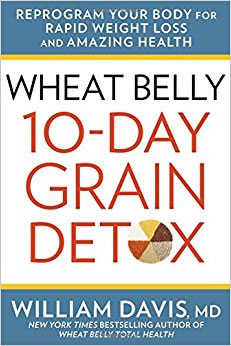A Quick-Start Health and Body Makeover
Below please find a summary of the recent book Wheat Belly 10-Day Grain Detox by William Davis, MD, the third installment in a series written by the New York Times bestselling author and cardiologist. After releasing Wheat Belly and Wheat Belly Total Health, both of which encouraged people to reverse chronic health problems by cutting grains and wheat from their diet, Dr. Davis released his third book as an “easy and accessible” 10-day detox program to help eliminate grains and wheat from meals.
Overall, while Wheat Belly 10-Day Grain Detox does exhort the negative effects of grains and wheat, a large portion of the book consists of dietary recommendations and recipes. In addition, Dr. Davis does not tend to cite any hard evidence, studies or statistics that support his grain- and wheat-free claims. In our ongoing efforts, GFF can continue to leverage our factual, grain-positive evidence and scientific advisory board members to debunk Dr. Davis’s claims.
Summary:
In Wheat Belly: 10-Day Grain Detox, Davis encourages readers to eliminate grains and wheat from their diet, claiming that scientific and clinical literature has shown that doing so leads to weight loss, drops in blood sugar, a reduction in overall calorie intake, lowered blood pressure and other health benefits. When no longer eating grains, people may initially feel worse because they have stopped the flow of partially digestible proteins found in grain products that yield opiate compounds. People should hydrate, stop exercising and take magnesium supplements to combat the effects of this initial grain withdrawal. Ultimately, though, following a 10-day detox by eliminating all grains, eating real, single-ingredient foods, and managing carbohydrate consumption will result in regaining whole-body health. Dr. Davis provides a 10-day menu plan with a variety of recipes for breakfast, lunch and dinner that he says do not reduce fat, get rid of excess oils, or limit calories or proportions; examples of meal and drink recipes include Mediterranean “pasta” salad; curried chicken soup; a chorizo, pepper and avocado skillet; and coconut magnesium water. Dr. Davis concludes the book by reiterating that cutting grains and wheat from the diet will lead to successful long-term weight-loss and health improvements. The benefits of grain and wheat elimination may include clearer skin, shrunken appetite, increased energy and a cleared gastrointestinal tract.
Key points:
- The 10-day detox can be broken into three steps:
- Cut all grains from the diet.
- By eliminating grains from the diet, people will rid themselves of the appetite-stimulating effects of grain-derived opiates, which encourage junk food consumption. People will also experience a reduced appetite and their sense of taste will be “reawakened.”
- Choose real, single-ingredient foods.
- By choosing foods that have not been modified by food manufacturers, there is no chance foods have been exposed to grains, added sugars and high-fructose corn syrup.
- Examples of single-ingredient foods include vegetables, beef, pork, eggs, avocados and raw or dry-roasted nuts and seeds.
- Manage carbohydrates.
- People must manage their intake of carbohydrates, even those not found in grains, because they slow weight-loss and health-improvement efforts.
- The detox follows a simple rule: never exceed 15 grams net carbohydrates per meal or per six-hour digestive period. Net carbs are calculated as net carbs = total carbohydrates – fiber content.
- Though carbohydrates must be managed on the detox, there are no limits on fats or oils. Rather, Dr. Davis encourages people to eat the fat from beef, pork, lamb or poultry. Dr. Davis also stresses avoiding gluten-free foods made with corn starch, rice flour, tapioca starch or potato flour because they may cause weight gain and inflammation.
- People must manage their intake of carbohydrates, even those not found in grains, because they slow weight-loss and health-improvement efforts.
- Cut all grains from the diet.
- During the grain detox, people must not only follow the three steps above, but also manage the following issues for guaranteed continued success:
- Manage “garden of bowel flora.”
- By consuming grains, people have disrupted the microorganism composition in their intestines that helps control weight, reduce blood pressure and encourage bowel regularity. People have eliminated a disturber in bowel regularity when they remove grains and should therefore reestablish bowel flora.
- To do so, Davis encourages people to plant “seeds” (or take probiotics that contain organisms the body may lack), and then “water and fertilize” the garden (or consume prebiotic fibers or resistant starches that nourish the species benefitting from the person, or the host).
- Consume the mineral zinc.
- Zinc supplementation is especially important during the first months of grain-free eating because it will help with gastrointestinal health recovery.
- Obtain fiber from foods other than grains and wheat.
- Beneficial cellulose-type fibers can be found in nuts and seeds such as almonds and peanuts. Vegetables, mushrooms and coconut are also good sources of fiber.
- Manage “garden of bowel flora.”
- “Detox-safe” flours should be used for meals.
- Flours used in meals should not contain any wheat or other grain and must be low in carbohydrates.
- Healthy, detox-worthy flours include:
- Garbanzo bean flour
- Hazelnut meal
- Pumpkin seed meal
- Walnut meal
- Besides restored energy and weight loss, the 10-day grain detox may lead to additional health benefits, including:
- Loss of cellulite
- Thicker hair
- Thicker and smoother nails
- Dental health improvements
- Breast size changes
- Breast size will likely be reduced for both men and women as a result of the correction of the hormone levels for estrogen and prolactin by removing grains from the diet.

